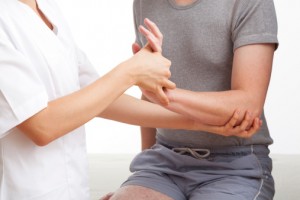
Joint Protection is important to hand and upper extremity rehabilitation. Our Friends at The Hale Hand Center came up with this list of techniques to help you protect your joints.
AVOID STRONG GRASP AND PINCH
- Use the palm instead of fingers whenever possible
- Use forearm for lifting and pulling (strap handles are helpful
when possible). - Avoid holding or maintaining a hand grasp for long periods of time.
- Take frequent breaks
USE STRONGER, LARGER JOINTS THAT ARE CLOSE TO THE TRUNK RATHER THAN SMALL JOINTS WHEN POSSIBLE
MAINTAIN OR INCREASE STRENGTH
- Do not exercise when joints are inflamed.
- Gentle resistive activities should be done for short periods of time within limits of pain. Balance with rest.
- Move within limits of pain and fatigue.
MAINTAIN OR INCREASE OF ENDURANCE
- Rest before fatigue ensues. Fatigue may cause careless use of joints and require longer rest period
- Promote recreational activities which are non-stressful to joints (example: swimming).
MAINTAIN OR INCREASE SKILL IN FUNCTIONAL TASKS WITH USE OF ADAPTIVE EQUIPMENT
- Long handles to extend reach
- Enlarged handles to decrease the grasp force required.
- Warm morning bath or shower to overcome stiffness and get moving.
EDUCATION
- Avoid jarring motions to joints
- Use lightweight, energy saving equipment
- Delete some jobs or give to someone else
- Plan ahead to balance rest and exertion
- Gather all necessary equipment ahead of time
- Make storage convenient
Joint Protection Techniques of Specific Activities
BATH
- Available adaptive equipment: bath bench, hand held shower, bath mitt, long handled bath sponge, two handed back scrubber.
CARRYING
- Ask bagger at grocery store to pack bags lightly.
- Hold shopping bag on the forearm.
- Lift a coffee cup with both hands.
- Slide pots and pans on kitchen counter to stove and sink.
- Use a wheeled cart to transport items
- Select only your lightest weight cooking ware to use. Do not try to handle heavy iron skillets.
- A terry cloth towel placed on a counter top will enable you to slide any object along a smooth surface with ease and without damage to counter top.
- Always use both hands. By using both hands you are redistributing the weight
- and amount of stress that is required to lift an object. Support heavy objects from the bottom.
DRESSING
- Front closing garments are easier to put on.
- Avoid garments with small buttons.
- Avoid clothing or footwear which requires excessive tugging to put on.
- Equipment to help perform dressing tasks – button aid, zipper aid, dressing
Stick, long handled reacher, and sock aid.
KITCHEN
- Use lightest weight cooking dishes. Lightweight plastic dishes are easier to wash and handle.
- Cooking dishes having loop handles on both sides are easier to handle.
- Soaking dishes eliminates need to scrub.
- Allow dishes to air dry.
- The step or returning clean dishes to the cupboard can be eliminated by reusing them directly from the dish drainer or dishwasher.
- Use an electric can opener.
- Nail board – to stabilize food to be cut, peeled or chopped.
LAUNDRY
- Do not wring out anything.
- Use a laundry cart to transport laundry
- Ironing – try a lightweight travel iron.
READING
- Prolonged reading should be done with book at eye level. May use a bookstand or tilt table.
